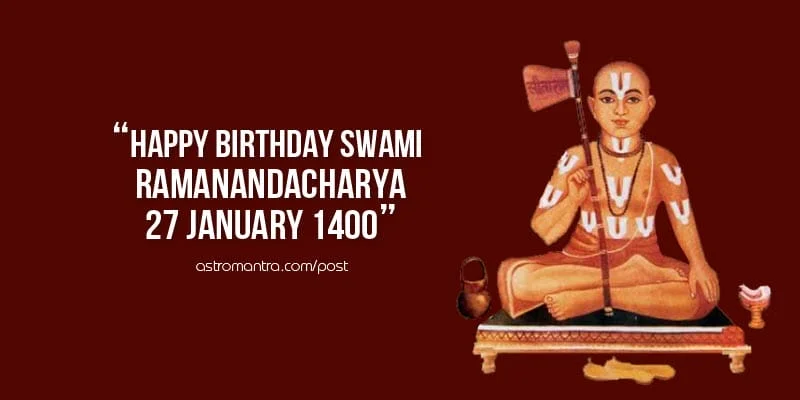Ramanandacharya Biography

Ramanandacharya Biography(रामानुचार्य): Ramanuja was a Hindu theologian, philosopher, and one of the most important exponents of the Sri Vaishnavism tradition within Hinduism. He was born in a Tamil Brahmin family in the village of Sriperumbudur Tamil Nadu. Sri Ramanuja (Ramanandacharya Biography) (1017 – 1137 CE), the most important philosopher-saint of Vaishnavam and one of the most dynamic characters of Hinduism was a philosophical as well as a social reformer, displaying a catholicity that was nearly unparalleled in Hindu religious history before him.
He revitalized Indian philosophy and popular religion so much that nearly every aspect of Hinduism has been influenced by his work. His life and works show a truly unique personality, combining contemplative insight, logical acumen, catholicity, charismatic energy, and selfless dedication to God. Ramanuja(Ramanandacharya Biography) was born in India during the year 1017 A.D. when, according to astrological calculations, the sun was in the zodiacal sign of Cancer. His parents were Asuri Keshava and Kantimati, both from aristocratic families. Ramanuja(Ramanandacharya Biography) passed his childhood days in Shriperumbudur, the village of his birth. At the age of 16 he was married to Rakshakambal.
Only four months after his wedding, Ramanuja’s father was struck with a severe illness and died. Upon the death of his father, Ramanuja became head of the household and decided to move to Kanchi, a holy city famed for its scholars and magnificent Temples. Ramanuja(Ramanandacharya Biography) opened a small school at his home, and in no time many people began to come to him to hear his devotional discourses. Ramanuja’s lectures were wholly theistic. He rejected the concept that the jiva, a living entity, could be equal to the Supreme Brahman or become God as postulated by Shankara.
The living entity, Ramanuja(Ramanandacharya Biography) taught, is a particle of Godhead, and as such, his position is to serve the complete whole. He said that as the hand is part of the body and thus a servant of the body, similarly the living entity is part of the Supreme and thus his constitutional position is to serve the Supreme. Ramanuja’s philosophy became known as vishishtadwaita or qualified non-dualism. Accordingly, the living entities are believed to be qualitatively one with the Supreme and at the same time quantitatively different.
Ramanuja’s assertion was that the quantitative difference means that the fragmentary parts of the Supreme are dependent on the Supreme but they cannot become the Supreme. Ramanuja (Ramanandacharya Biography) nominated 74 Acharyas to succeed him. It is he who instituted the 13 day “iyal Goshti in Srirangam. Ramnuja’s service to promote our Sri Sampradaym grew day by day and he established a system at SriRangam temple which is called as “Koilolugu” to perform the daily rituals and procedures to run the temple. This is followed even today.
After this he went to Tirumala and established a system and created a mutt(religious institution) to organize the activities of the Tirumala temple. He had written various books on our Sri Sampradayam. He established the Vishistadvaita philosophy based on the Vedas and alwars’ Divya Prabandam. He appointed 74 simharihipathis to spread our sampradayam. He established a temple for Sriman Narayana in a place called Thirunarayanapuram (called as Melkote) in Karnataka state near Mysore. His works continued and he was taking all efforts to spread our Sri Sampradayam (Ramanandacharya Biography)till his last. He lived for 120 years and attained Vaikuntapathi from SriRangam.
रामानुचार्य जीवन परिचय | Ramanandacharya Biography
रामानुजाचार्य विशिष्टाद्वैत वेदान्त के प्रवर्तक थे। वह ऐसे वैष्णव सन्त थे जिनका भक्ति परम्परा पर बहुत गहरा प्रभाव रहा। वैष्णव आचार्यों में प्रमुख रामानुजाचार्य की शिष्य परम्परा में ही रामानन्द हुए जिनके शिष्य कबीर और सूरदास थे। रामानुज ने वेदान्त दर्शन पर आधारित अपना नया दर्शन विशिष्ट अद्वैत वेदान्त लिखा था। रामानुजाचार्य ने वेदान्त के अलावा सातवीं-दसवीं शताब्दी के रहस्यवादी एवं भक्तिमार्गी आलवार सन्तों के भक्ति-दर्शन तथा दक्षिण के पंचरात्र परम्परा को अपने विचारों का आधार बनाया। १०१७ ईसवी सन् में रामानुज का जन्म दक्षिण भारत के तमिल नाडु प्रान्त में हुआ था। बचपन में उन्होंने कांची जाकर अपने गुरू यादव प्रकाश से वेदों की शिक्षा ली। रामानुजाचार्य आलवार सन्त यमुनाचार्य के प्रधान शिष्य थे। गुरु की इच्छानुसार रामानुज से तीन विशेष काम करने का संकल्प कराया गया था – ब्रह्मसूत्र, विष्णु सहस्रनाम और दिव्य प्रबन्धम् की टीका लिखना।
उन्होंने गृहस्थ आश्रम त्याग कर श्रीरंगम् के यतिराज नामक संन्यासी से सन्यास की दीक्षा ली। मैसूर के श्रीरंगम् से चलकर रामानुज शालिग्राम नामक स्थान पर रहने लगे। रामानुचार्य ने उस क्षेत्र में बारह वर्ष तक वैष्णव धर्म का प्रचार किया। उसके बाद तो उन्होंने वैष्णव धर्म के प्रचार के लिये पूरे भारतवर्ष का ही भ्रमण किया। ११३७ ईसवी सन् में १२० वर्ष की आयु पाकर वे ब्रह्मलीन हुए। रामानुचार्य के दर्शन में सत्ता या परमसत् के सम्बन्ध में तीन स्तर माने गये हैं – ब्रह्म अर्थात् ईश्वर, चित् अर्थात् आत्म तत्व और अचित् अर्थात् प्रकृति तत्व। वस्तुतः ये चित् अर्थात् आत्म तत्त्व तथा अचित् अर्थात् प्रकृति तत्त्व ब्रह्म या ईश्वर से पृथक नहीं है बल्कि ये विशिष्ट रूप से ब्रह्म के ही दो स्वरूप हैं एवं ब्रह्म या ईश्वर पर ही आधारित हैं।
वस्तुत: यही रामानुचार्य का विशिष्टाद्वैत का सिद्धान्त है। जैसे शरीर एवं आत्मा पृथक नहीं हैं तथा आत्म के उद्देश्य की पूर्ति के लिये शरीर कार्य करता है उसी प्रकार ब्रह्म या ईश्वर से पृथक चित् एवं अचित् तत्त्व का कोई अस्तित्व नहीं हैं। वे ब्रह्म या ईश्वर का शरीर हैं तथा ब्रह्म या ईश्वर उनकी आत्मा सदृश्य हैं। रामानुचार्य ने विवाह किया और कांचीपुरम में चले गये, उन्होंने अपने गुरु यादव प्रकाश के साथ अद्वैत वेदांत मठ में अध्ययन किया। रामानुजाचार्य और उनके गुरु अक्सर वैदिक ग्रंथों, विशेषकर उपनिषदों की व्याख्या में असहमत रहते थे। बाद में रामानुजाचार्य और यादव प्रकाश अलग हो गए, और इसके बाद रामानुचार्य ने अपनी पढ़ाई जारी रखी। रामानुचार्य कांचीपुरम में वरधराजा पेरुमल मंदिर (विष्णु) में एक पुजारी बन गए, जहां उन्होंने यह पढ़ाना शुरू कर दिया कि मोक्ष (मुक्ति और संसार से छुटकारा) आध्यात्मिक, निरगुण ब्राह्मण के साथ नहीं, बल्कि व्यक्तिगत भगवान और साधू विष्णु की सहायता से प्राप्त करना है।
रामानुचार्य ने श्री वैष्णव परंपरा में लंबे समय से सबसे अधिक अधिकार का आनंद लिया। रामानुचार्य वेदांत के विशिष्टाद्वैत सबस्कुल के प्रमुख प्रत्याशी के रूप में प्रसिद्ध हैं, और उनके शिष्यों को संभवतः शांतियानी उपनिषद जैसे लेखों के लेखकों के रूप में जाना जाता है। रामानुचार्य ने स्वयं ब्रह्मा सूत्रों और भगवद गीता पर भक्ति जैसे संस्कृत के सभी प्रभावशाली ग्रंथ लिखे थे। उनके विशिष्टाद्वैत (योग्य मोनिस्म) दर्शन में माधवचर्या के द्वैता (ईश्वरीय द्वैतवाद) दर्शन और शंकराचार्य के अद्वैत (अद्वैतवाद) दर्शन, साथ में दूसरे सहस्त्राब्दि के तीन सबसे प्रभावशाली वेदांतिक दर्शन थे। रामानुचार्य ने उपन्यास प्रस्तुत किया जिसमे भक्ति के सांसारिक महत्व और एक व्यक्तिगत भगवान के प्रति समर्पण को आध्यात्मिक मुक्ति के साधन के रूप में प्रस्तुत किया।


